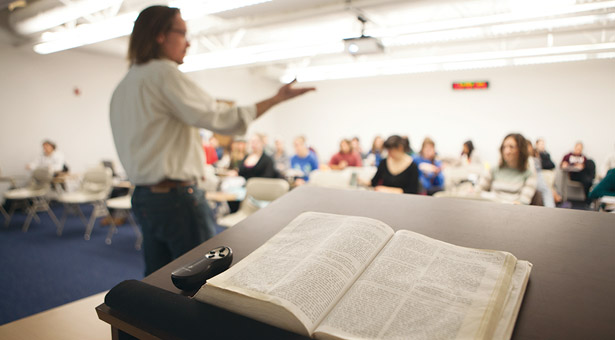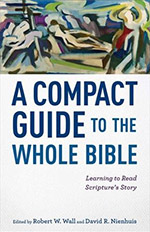The Bible & Theology Toward Christian Maturity
Teaching the Text
Developed in SPU Classes, Bible Guide Illuminates Scripture
By Jeffrey Overstreet (jeffreyo@spu.edu) | Photo by Luke Rutan
 Scripture is central to University Foundations classes taught by Seattle Pacific School of Theology professors, including Associate Professor of New Testament Studies David Nienhuis (left).
Scripture is central to University Foundations classes taught by Seattle Pacific School of Theology professors, including Associate Professor of New Testament Studies David Nienhuis (left).
Right away, Sam Filby learned that University Foundations 2000 was no ordinary Bible class.
During Autumn Quarter 2013, Filby and his classmates in UFND 2000 “Christian Scriptures” — taught by Robert Wall, the Paul T. Walls professor of Scripture and Wesleyan Studies — learned that they would be offering feedback on a work-in-progress authored by the faculty of Seattle Pacific.

Filby, a double-major in philosophy and classics, says that his understanding of Scripture was transformed. “Because of the influence of myths and symbols like those in Milton’s Paradise Lost, we have a lot of ideas about what is in the biblical text that are not actually present in the text,” he says. “The book helped us understand the rich symbolism and overcome our confusion about the texts.”
A Compact Guide to the Whole Bible (Baker Academic, 2015) is a small book that meets a big need — not just in SPU classrooms, but in schools, churches, and homes.
In their introduction, co-editors Wall and David Nienhuis, associate professor of New Testament studies, write, “What could be worse than a biblical studies course that spends all its time teaching readers about the Bible but never creates space for a deep, extended encounter with it?” With the Compact Guide’s thorough and succinct introduction to the Bible, they’ve developed a way of teaching about the Bible that gives readers knowledge and confidence to encounter Scripture.
“It provides, in written form, a short and accessible lecture that students can read before class,” Wall says. “That way they don’t have to sit and listen to a lecture; we can instead talk about things covered in that chapter in more detail, according to the interest of the classroom.”
“It was an opportunity to engage with that text, instead of just having an authority tell us what to think,” says Filby.
Wall, Nienhuis, and their co-writers — Daniel Castelo, Laura Holmes, Sara Koenig, Eugene Lemcio, Bo Lim, Chad Marshall, and Frank Spina — sought to familiarize readers with the Bible’s nature, its canonical design as “a collection of collections,” and the Bible’s plotline, the whole story, from Genesis to Revelation.
If students have both the nature and the plotline in mind, says Wall, they can interpret what they read with skill, and carry on a conversation about what they’ve read with friend and foe alike.
“Part of our competence as Christians depends on our capacity to know the Bible well enough to take on those who are hostile toward Christian faith,” he says.
Savannah Ojendyk, a nursing student who recently transferred to SPU, says that she felt anxious about entering her first religion class. “The Bible seemed to be this thing on a pedestal — something I couldn’t really touch. But I realized that once you get the basic idea of the Bible’s metanarrative, you can really dig into what’s actually there. It ended up being my favorite class last quarter. I came away wanting more. The Compact Guide made the Bible more approachable.”
The result is impressing scholars and church leaders as well. David Kendall, a bishop in the Free Methodist Church, recommends the book “to those charged with communicating the story, to those whose lives should reflect the story, and to all seekers for whom the story begs to be told.”
